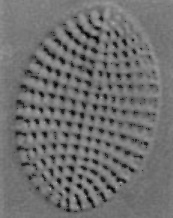 When diatoms
die they sink to the bottom of the water column where they accumulate.
The slow dissolution of silica, and high productivity of some diatoms lead
to the accumulation of oozes. Deep ocean sediment containing a minimum
of 30% biogenic material is called an ooze. Since the tests or shells of
diatoms are formed from silica they form siliceous, or sio2 rich oozes.
When diatoms
die they sink to the bottom of the water column where they accumulate.
The slow dissolution of silica, and high productivity of some diatoms lead
to the accumulation of oozes. Deep ocean sediment containing a minimum
of 30% biogenic material is called an ooze. Since the tests or shells of
diatoms are formed from silica they form siliceous, or sio2 rich oozes.
Siliceous oozes predominate at greater depths in polar regions. Diatom oozes are most common in the Antarctic, because strong currents and seasonal upwelling of nutrients in this area form large populations of diatoms. Diatoms take about 50 years to fall to the bottom of the ocean after they die, which would cause a great deal of displacement, but the composition of deep bottom sediments is similar to particle composition in the water column. The similarity in composition is caused by the diatoms contained in the fecal pellets of other animals, which fall much faster, in about two weeks.